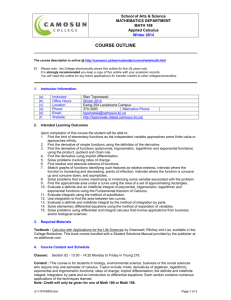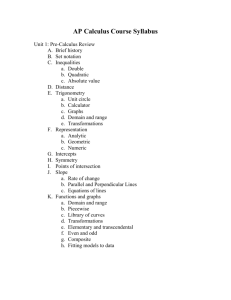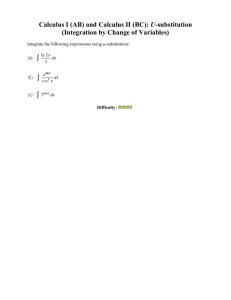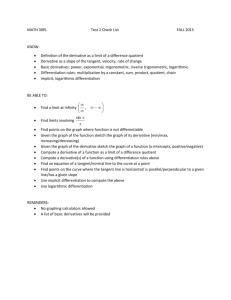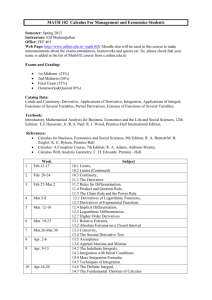MATH-108-001 Susie Wieler
advertisement
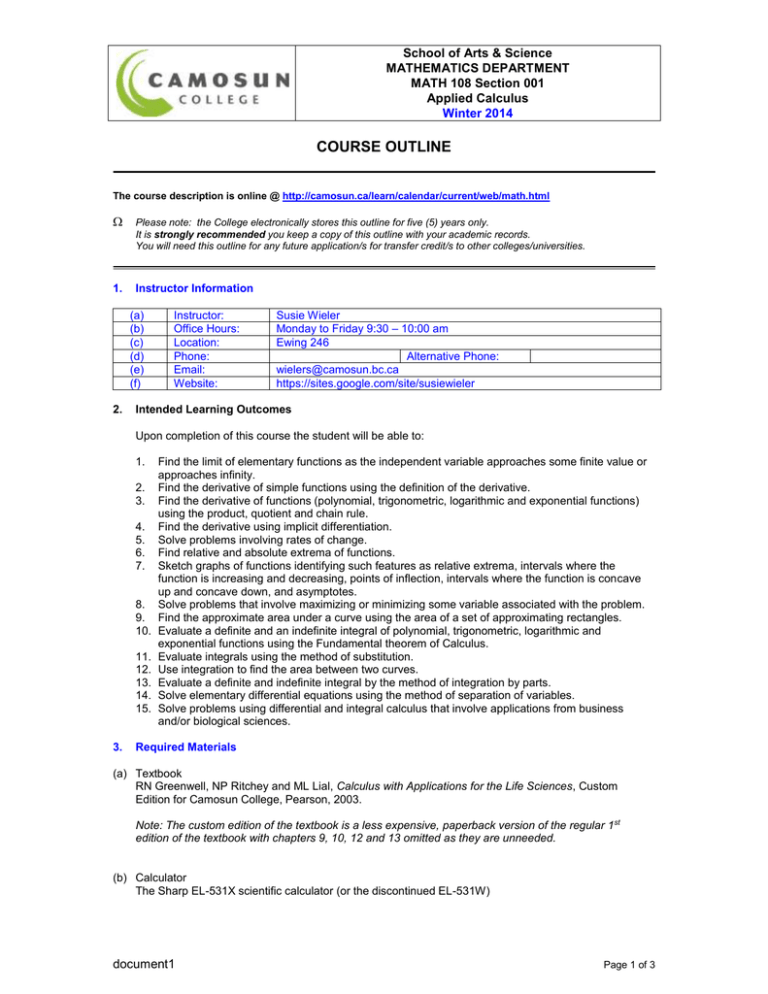
School of Arts & Science MATHEMATICS DEPARTMENT MATH 108 Section 001 Applied Calculus Winter 2014 COURSE OUTLINE The course description is online @ http://camosun.ca/learn/calendar/current/web/math.html 1. Please note: the College electronically stores this outline for five (5) years only. It is strongly recommended you keep a copy of this outline with your academic records. You will need this outline for any future application/s for transfer credit/s to other colleges/universities. Instructor Information (a) (b) (c) (d) (e) (f) 2. Instructor: Office Hours: Location: Phone: Email: Website: Susie Wieler Monday to Friday 9:30 – 10:00 am Ewing 246 Alternative Phone: wielers@camosun.bc.ca https://sites.google.com/site/susiewieler Intended Learning Outcomes Upon completion of this course the student will be able to: 1. 2. 3. 4. 5. 6. 7. 8. 9. 10. 11. 12. 13. 14. 15. 3. Find the limit of elementary functions as the independent variable approaches some finite value or approaches infinity. Find the derivative of simple functions using the definition of the derivative. Find the derivative of functions (polynomial, trigonometric, logarithmic and exponential functions) using the product, quotient and chain rule. Find the derivative using implicit differentiation. Solve problems involving rates of change. Find relative and absolute extrema of functions. Sketch graphs of functions identifying such features as relative extrema, intervals where the function is increasing and decreasing, points of inflection, intervals where the function is concave up and concave down, and asymptotes. Solve problems that involve maximizing or minimizing some variable associated with the problem. Find the approximate area under a curve using the area of a set of approximating rectangles. Evaluate a definite and an indefinite integral of polynomial, trigonometric, logarithmic and exponential functions using the Fundamental theorem of Calculus. Evaluate integrals using the method of substitution. Use integration to find the area between two curves. Evaluate a definite and indefinite integral by the method of integration by parts. Solve elementary differential equations using the method of separation of variables. Solve problems using differential and integral calculus that involve applications from business and/or biological sciences. Required Materials (a) Textbook RN Greenwell, NP Ritchey and ML Lial, Calculus with Applications for the Life Sciences, Custom Edition for Camosun College, Pearson, 2003. Note: The custom edition of the textbook is a less expensive, paperback version of the regular 1st edition of the textbook with chapters 9, 10, 12 and 13 omitted as they are unneeded. (b) Calculator The Sharp EL-531X scientific calculator (or the discontinued EL-531W) document1 Page 1 of 3 4. Course Content and Schedule Chapter R: Algebra Reference – for reference/review R.1 Polynomials R.2 Factoring R.3 Rational Expressions R.4 Equations R.5 Inequalities R.6 Exponents R.7 Radicals Chapter 1: Functions 1.1 Lines and Linear Functions 1.3 Properties of Functions 1.4 Quadratic Functions; Translation and Reflection 1.5 Polynomial and Rational Functions Chapter 2: Exponential, Logarithmic, and Trigonometric Functions 2.1 Exponential Functions 2.2 Logarithmic Functions 2.3 Applications: Growth and Decay 2.4 Trigonometric Functions Chapter 3: The Derivative 3.1 Limits 3.2 Continuity 3.3 Rates of Change 3.4 Definition of the Derivative 3.5 Graphical Differentiation Chapter 4: Calculating the Derivative 4.1 Techniques for Finding Derivatives 4.2 Derivatives of Products and Quotients 4.3 The Chain Rule 4.4 Derivatives of Exponential Functions 4.5 Derivatives of Logarithmic Functions 4.6 Derivatives of Trigonometric Functions Chapter 5: Graphs and the Derivative 5.1 Increasing and Decreasing Functions 5.2 Relative Extrema 5.3 Higher Derivatives, Concavity, and the Second Derivative Test 5.4 Curve Sketching Chapter 6: Applications of the Derivative 6.1 Absolute Extrema 6.2 Applications of Extrema 6.3 Implicit Differentiation 6.4 Related Rates 6.5 Differentials: Linear Approximation Chapter 7: Integration 7.1 Antiderivatives 7.2 Substitution 7.3 Area and the Definite Integral 7.4 The Fundamental Theorem of Calculus 7.5 Integrals of Trigonometric Functions 7.6 The Area Between Two Curves Chapter 8: Further Techniques and Applications of Integration 8.2 Integration by Parts Chapter 11: Differential Equations 11.1 Solutions of Elementary and Separable Differential Equations EXTRA: Newton's Method (class notes) 5. Basis of Student Assessment (Weighting) Quizzes A short quiz will be given at the beginning of class on Wednesdays. Test Dates Test 1 – February 7 (a) Quizzes (b) Tests (c) Final Exam 5% 45% 50% document1 Test 2 – March 7 Test 3 – April 4 Your lowest two quiz marks will be dropped. Page 2 of 3 6. Grading System Standard Grading System (GPA) Percentage Grade 90-100 85-89 80-84 77-79 73-76 70-72 65-69 60-64 A+ A AB+ B BC+ C 50-59 D 0-49 F Description Grade Point Equivalency 9 8 7 6 5 4 3 2 Minimum level of achievement for which credit is granted; a course with a "D" grade cannot be used as a prerequisite. Minimum level has not been achieved. 1 0 Temporary Grades Temporary grades are assigned for specific circumstances and will convert to a final grade according to the grading scheme being used in the course. See Grading Policy E-1.5 at camosun.ca for information on conversion to final grades, and for additional information on student record and transcript notations. Temporary Grade I IP CW 7. Description Incomplete: A temporary grade assigned when the requirements of a course have not yet been completed due to hardship or extenuating circumstances, such as illness or death in the family. In progress: A temporary grade assigned for courses that, due to design may require a further enrollment in the same course. No more than two IP grades will be assigned for the same course. (For these courses a final grade will be assigned to either the 3rd course attempt or at the point of course completion.) Compulsory Withdrawal: A temporary grade assigned by a Dean when an instructor, after documenting the prescriptive strategies applied and consulting with peers, deems that a student is unsafe to self or others and must be removed from the lab, practicum, worksite, or field placement. Recommended Materials or Services to Assist Students to Succeed Throughout the Course LEARNING SUPPORT AND SERVICES FOR STUDENTS There are a variety of services available for students to assist them throughout their learning. This information is available in the College calendar, at Student Services, or the College web site at camosun.ca. STUDENT CONDUCT POLICY There is a Student Conduct Policy which includes plagiarism. It is the student’s responsibility to become familiar with the content of this policy. The policy is available in each School Administration Office, at Student Services, and the College web site in the Policy Section. The MATH LAB is located in Ewing 224. This drop-in centre is freely available for your use to work on math homework and to seek help from the tutor on staff (see hours posted on door). document1 Page 3 of 3

